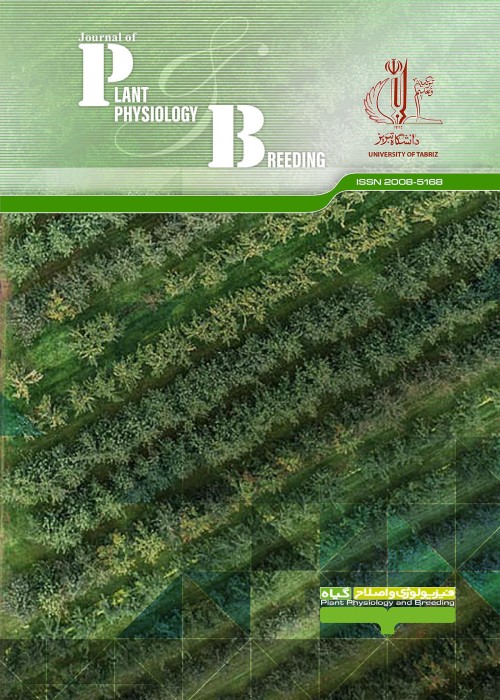Genetic diversity among barley genotypes and path analysis of several agronomic and physiological characters at normal and salinity stress conditions
Author(s):
Article Type:
Research/Original Article (دارای رتبه معتبر)
Abstract:
The current research was performed to evaluate 150 barley cultivars based on several agronomic and physiological traits. The experiment was conducted as an alpha lattice design with five incomplete blocks in two replications at normal and salinity stress (EC= 12 dsm-1) conditions at Agriculture and Natural Resources Research and Education Center, Yazd, Iran, for two years. The combined analysis of variance showed a significant difference among genotypes in all traits except harvest index and relative water content, indicating the existence of genetic diversity among the evaluated barley genotypes. Phenotypic correlation coefficients based on the average of two cropping years showed that biological yield, days to physiological maturity, and leaf chlorophyll index under normal conditions and biological yield, harvest index, number of fertile tillers, and plant height under salinity stress had a significant positive correlation with grain yield. According to the path analysis, the days to physiological maturity and number of fertile tillers had the highest positive direct effect on grain yield in normal and salinity stress conditions, respectively, followed by leaf chlorophyll index in the normal conditions and plant height under salinity stress. Cluster analysis by Ward’s method grouped the studied genotypes into three clusters in both environments based on an average of two years. The discriminant function analysis was used to determine the number of clusters and check the accuracy of the grouping in the cluster analysis. Percentage deviation from the grand mean of clusters under salinity stress showed that genotypes of the first cluster had the highest grain yield and have the shortest maturity period. In the second cluster, physiologically efficient genotypes, and in the third cluster, late maturing and low-yielding genotypes were included. Therefore, according to the results of this study, it can be concluded that under salinity stress, the genotypes of the first cluster with the highest grain yield and earliest maturity dates can be used in future breeding programs to improve the salinity tolerance.
Keywords:
Language:
English
Published:
Journal of Plant Physiology and Breeding, Volume:11 Issue: 2, Summer-Autumn 2021
Pages:
121 to 134
magiran.com/p2423938
دانلود و مطالعه متن این مقاله با یکی از روشهای زیر امکان پذیر است:
اشتراک شخصی
با عضویت و پرداخت آنلاین حق اشتراک یکساله به مبلغ 1,390,000ريال میتوانید 70 عنوان مطلب دانلود کنید!
اشتراک سازمانی
به کتابخانه دانشگاه یا محل کار خود پیشنهاد کنید تا اشتراک سازمانی این پایگاه را برای دسترسی نامحدود همه کاربران به متن مطالب تهیه نمایند!
توجه!
- حق عضویت دریافتی صرف حمایت از نشریات عضو و نگهداری، تکمیل و توسعه مگیران میشود.
- پرداخت حق اشتراک و دانلود مقالات اجازه بازنشر آن در سایر رسانههای چاپی و دیجیتال را به کاربر نمیدهد.
In order to view content subscription is required
Personal subscription
Subscribe magiran.com for 70 € euros via PayPal and download 70 articles during a year.
Organization subscription
Please contact us to subscribe your university or library for unlimited access!




